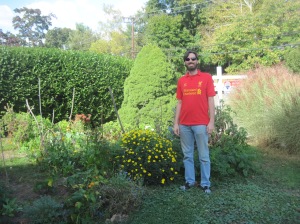After I left the Marines in 1994, I ended up working briefly in northern Montana on a ranch in the middle of the Blackfoot Indian Reservation. The Two Medicine River ran through the ranch lands and it was a gloriously beautiful place to be in Big Sky Country. That year I participated in the ranch’s fall round up of cattle off of the open range to bring them to winter pastures that surrounded the headquarters of the ranch. The round up took several days of old fashioned cowboy work on quarter horses, rounding up cattle spread far and wide over open range and then driving them the 15 or so miles to the main pastures, and then working the cattle at the barns (this involved inoculations, worming, castration of male calves etc). We were miles from everything, a trip to the post office was 30 miles and over half of the trip was on unpaved roads, there were hardly any people around and the sky was HUGE. That provides quite the contrast to where I find myself now nearly 20 years on, in Southern New England and the fall round up only involves harvesting the garden (having been kicked, head butted, stomped on and smashed into the barn wall by cattle in my life, this is not necessarily unwelcome).
New England is famous for the show the forests put on every year at this time. The various deciduous trees so prevalent here, elms, beeches, birches, maples, and oaks of various kinds, start to shutdown for the winter and stop the flow of nitrogen to their leaves. As the nitrogen seeps out the leaves turn their beautiful shades of red, yellow, and brown creating panoramic views of stunning autumnal splendor. Walking in the woods for me at this time of the year is wonderful. Autumn is also the traditional time of harvest celebrations and getting prepped for winter as the temperatures start to dip. A quick check of the NOAA weather site (no commercials!) tells me that lows will be in the mid to upper 30s this week in Branford. Chilly!
Despite the dips in temps, my garden still has some beautiful, healthful food to yield. The beans are all ready to harvest and are dry in their pods. Carrots too should be getting sweeter as the temperatures cool. Being biennial, carrots will over winter in the ground living off of the starchy root until spring. Then it will put up new greens, flower and go to seed at the end of its cycle. The kale and collard greens are still going strong and probably will for quite some time yet. I have seen kale growing and green with snow around it in Pennsylvania, so I think it will be good for a while. There are still two potato mounds left to harvest and even some peppers that are hanging on. I doubt the tomato flowers will mature though!
The garden was challenging this year due to the starting soil ph (4.6 yikes!) and the subsequent unintentional neglect mid-season when I was off my feet for a few weeks due to a little mountain biking accident. The garden received very little care at the time, including little water, yet still produced because of the polycultures I had set up and all the compost I amended the soil with. Appropriate plant groupings are key as certain plants work well together and in many instances HELP one another. Pests get confused when plants are in mixed plantings, soil retains moisture better when densely vegetated, and shaded, and beneficial pollinators come to all the flowers. This is a small part of what permaculture is all about. It is so much more too. The key is to get started!
Now is the perfect time to prep your garden for next year. Save your leaves and get some plain brown cardboard. Place a layer of cardboard directly on the surface of the ground. Top with leaves and wet them down. Placing more layers than one is preferable if materials are readily available. The cardboard and leaves will biodegrade and create rich, dark humus as well as inviting worms to come to the spot. The mulch will prevent grass and other plants from growing until removed for planting. Sheet mulching is a great way to expedite the soil building process. It removes cardboard and leaves from the waste stream and cycles them back into a system. Win, win!
Gardening has a positive domino effect for us. It lessens food miles, increases activity, connects us to nature, and can build community through sharing surplus tools, produce, knowledge, and labor. It is a highly educational activity and there are many ways to include children as well. In short, gardening is vital to a thriving, healthy community. Grow an organic garden!

Bright flowers attract pollinators and other beneficial insects as well as creating beauty in the garden.















